

 Vol. 39 (# 10) Year 2018. Page 29
Vol. 39 (# 10) Year 2018. Page 29
Pedro ROMÁN Graván 1; Cristóbal BALLESTEROS Regaña 2; María Dolores Díaz NOGUERA 3
Received: 18/10/2017 • Approved: 25/11/2017
ABSTRACT: The present article shows the development of a study that analyzed the possibilities of academic WhatsApp groups as alternative communication systems for virtual tutoring in the university environment. Through a descriptive study with 317 students from three different degrees, the results obtained indicate that the implementation of academic WhatsApp groups would make a helpful tool for improving the communication with their classmates and the virtual tutoring with their teachers, increasing their level of written expression and participation. |
RESUMEN: El artículo muestra un estudio que analizó las posibilidades de los grupos académicos de WhatsApp como sistemas de comunicación alternativa para la tutoría virtual en el entorno universitario. Mediante un estudio descriptivo con 317 estudiantes de tres grados diferentes, los resultados indican que la implementación de los grupos académicos de WhatsApp sería una herramienta útil para mejorar la comunicación con sus compañeros y la tutoría virtual con sus maestros, incrementando su nivel de expresión escrita y participación. |
The advances in coverage and usability that have taken place in mobile technology during the last decade have turned it into one of the most extended and employed communication tools in western countries. In this line, different reports about the future trends of technologies for learning (Durall, Gros, Maina, Johnson y Adams, 2012; Fundación Telefónica, 2012, 2014; UNESCO, 2017; Horizonte 2020, 2017) claim that mobile devices are among the technologies with greatest impact in the short and medium term.
In this “adjectival media context from a perspective of portability and ubiquity” (Vázquez, Mengual y Roig, 2015, p. 86), mobile devices are digital tools that can stimulate and enhance relationships between people and teams; according to Castells (2007, p. 267), they are also “flow areas between the people connected to the network”. This extension of mobile communication is strengthening the technological platform of network society, whose structure and social habits are beginning to organise around microelectronic networks of information and communication (Flores, 2009; Bañon, 2010; Vázquez, Mengual y Roig, 2015). As indicated in the report by Scopeo (2011, p. 47), “the mobile phone is the last thing we touch before going to sleep and the first thing we check when we wake up”.
Therefore, we encounter a technological reality that can provide possibilities to enrich and improve the development of teaching processes, in general, and virtual tutoring and communication, in particular (Hwang, Huang & Wu, 2011), improving communication between learning groups through the exchange of educational necessities, objectives, contents and support means-resources. The possibilities offered by this technological reality also include the adaptation of didactic methodologies to their real practice contexts, and these can be expanded, integrated and personalised outside the classroom (Bastos, Bottentuit, Costa & Oliveira, 2016).
As a consequence, in the last few years, this potential of mobile devices has been accompanied by a progressive increase in the number of studies conducted on the use of WhatsApp (Church & Oliveira, 2013; Soliman & Salem, 2014; Devi & Tevera, 2014; De Freitas, 2015); however, there are still very few studies focused on its functionalities and effects as alternative communication systems to improve the tutoring and virtual follow-up of the educational processes in university teaching (Bere, 2012; Yeboah & Ewur, 2014; Fuentes, García y Aranda, 2017).
The literature review also reveals the linguistic relations and peculiarities of instant messaging and short-message services, as detailed in the studies that analysed the use of language in mobile applications and its evolution through time (Baron, 2010; Chiluwa, 2010; Crystal, 2010; Androutsopoulos, 2011; Plá, 2014; and Pérez & Montero, 2015).
1. What are the consequences of using tools like WhatsApp in the personal relationships and academic communication of Higher Education students?
2. Are the Academic WhatsApp groups suitable and relevant as alternative communication systems in virtual tutoring?
The purpose of this study was to determine the relevance and suitability of using academic WhatsApp groups as alternative communication systems for virtual tutoring in university teaching. To this end, a survey was conducted with university students from three different degrees of the Faculty of Education Sciences at the University Seville.
By collaborating in an academic WhatsApp group, teachers can instantly send their students notifications related to the subject matter, in general, or practical activities, in particular, as also stated by Rambe & Bere (2013), at the Free State University (South Africa), where alternative dialogic spaces are created within informal contexts, in which they feel less embarrassed. However, this can also have negative effects, such as those detected by Karapanos, Teixeira & Gouveia (2016), of the University of Madeira (Portugal), who reported embarrassing situations experienced by some students who participated in these groups when some of their classmates did not take their interventions seriously and/or they were ridiculed in this type of virtual environment, where even unexpected situations of harassment can occur in the network.
In this line, Bere & Rambe (2013), teachers at the Central University of Technology (South Africa), worked on the Technology Acceptance Model (TAM) with a total of 196 students (63 men and 133 women) between 20 and 32 years of age. They concluded that the variables that define TAM are: perceived convenience, ease of use, perceived usefulness, behavioural intention to use, attitude toward using these means and actual system use; this is what makes students want to use WhatsApp with educational purposes.
The present study was based on a descriptive methodology within the field of research applied to ICT, as referenced by professors Cabero y Barroso (2010) of the University of Seville., who currently differentiate two major lines of research related to technology and education:
a) Studies in which technology emphasises training, i.e. computers as tutors, intelligent text processors that guide students or the use of simulators to acquire skills and competences.
b) Studies in which the means act as teaching support, including different aspects that range from the interaction that may be established in new environments, to how these means are designed for education or the application of specific strategies for education.
The study population was constituted by all the students registered in the Faculty of Education Sciences at the University of Seville during the first term of the academic year 20015-2016, which started at the beginning of September 2015 and ended in mid-January 2016. The population was organised in degrees (Early Childhood Education, Primary Education, Pedagogy and Physical Education), courses (from 1st year to 4th year) and groups (a maximum of 9 groups in that academic year 2015-2016, although not all the degrees offered had the same number of groups). The total number of students provided by the secretariat of the centre during that academic year was 4,414 students, distributed as follows in Table 1.
Table 1
Students registered in the different degrees of the Faculty of Education
Sciences at the University of Seville during the academic year 2015-16.
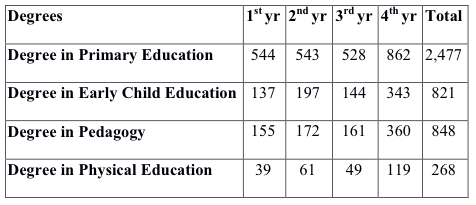
Therefore, a non-random or intentional sampling was performed in this study, and the criterion was the ease of the researchers to access the students. Regarding the strata, the authors intended to include a representation of the students of all the degrees taught in the Faculty of Education Sciences at the University of Seville, of all the class groups, of all shifts (morning and afternoon), and of men and women; the last aspect was a bit more complex, since in this type of degrees the registered students are mostly females. The formula to calculate the sample size under these type of parameters is the following (Hernández, Fernández y Baptista, 2007):

Where the letters stand for:
n: is the sample size or subjects to be surveyed.
N: is the population or universe size (in this case, N = 4,414).
k: is a constant that depends on the confidence level assigned. It indicates the probability that the results could be true; for instance, a 90% confidence level is the same as saying that the probability of error is 10%. The k values most frequently used and their confidence levels are shown in Table 2.
Table 2
k value according to confidence level.

In the present study, a k value of 1.96 was assigned, i.e. a confidence level of 95% or a probability of error of 5%.
e: is the sample error desired. It is the difference that may be between the result obtained by asking a population sample and the result that would be obtained if the entire population was asked (obviously, more reliable and real).
p: is the proportion of individuals in the population that have the study characteristic. This datum is generally unknown and it is usually presumed that p=q=0.5, which is the safest option.
q: is the proportion of individuals that do not have this characteristic, i.e. it is 1 - p.
There are websites that even provide easy and simple sampling calculations, such as Feedback Networks (http://bitly.com/calculador-muestra).
In the present study, the formula yielded a value of 317 respondents, and a total of 325 questionnaires were gathered; thereby, the statistical requirements were sufficiently met. Of the total of participants, 81.5% were women and 18.5% were men. This is a complex datum of equals, since the different degrees offered are mostly undertaken by females.
Regarding the age of the students, 52.9% were between 18 and 20 years, 29.8% were between 21 and 23 years, and the third big block was constituted by 9.8% of students between 24 and 26 years. The degrees in which the participants were registered are: Primary Education (67.1%), Early Child Education (19.1%), and Pedagogy (13.5%).
With respect to the course the students were studying at the time of the present research, 52% were in the 1st year, 12.9% in the 2nd year, 12.3% in the 3rd year, and 18.8% in the 4th year. Lastly, regarding the group in which the participants were registered, 14.8% were in the first group, 8.6% in the second group, 32.9% in the third group, 2.2% in the fourth group, 16.3% in the sixth group, 4.3% in the seventh group, and 20.3% in the eighth group.
The instrument used to gather information was a questionnaire designed ad hoc, and it consisted of 24 closed-ended questions. It was designed and administered through Google Forms and later exported to an Excel document.
In the first part of the questionnaire, the items were multiple-choice questions (items 1 to 11), and in the second part the questions were answered through a Likert-like Scale that ranged from 1 point (not suitable at all / not relevant at all / not valid at all…) to 10 points (very suitable / very relevant / very valid…). The aim of including only closed-ended questions was to obtain information that could be compared in the simplest and most immediate manner possible. The questionnaire was uploaded in the following website for the participants to complete it: http://bitly.com/whatsapp-academico.
The instrument consisted of two well-defined parts. The first part asked the participants about the identification data, such as gender, age, university in which they were registered, degree, course, group, mobile phone brand, age of the device, current telephone company hired and the one in the previous year, and the type of data plan purchased. In the second part a Likert-like Scale was used, where 1 = not suitable at all or not relevant at all, and 10 = very suitable or very relevant, as mentioned earlier.
The questions were related to several dimensions: motivation, participation/collaboration, reading-writing competences, and knowledge building.
With respect to motivation, the participants were asked whether the use of academic WhatsApp groups would increase their motivation to follow and study the modules in which these were used, whether by participating in such a group would increase their interest toward the module, and whether by collaborating in one of these groups the teacher could provide instant notifications related to the subject matter, in general, or the practical activities, in particular.
The items included in the dimension “participation/collaboration” gathered information about whether the use of academic WhatsApp groups would increase the participation of students in the modules in which these were used, whether their use would allow them to make decisions as a group on academic issues related to the modules (handing in assignments, revisions, lecturing, etc.), whether these groups would allow them to share pictures or videos related to the modules that would help them comprehend concepts, procedures or attitudes, and whether the use of these groups is very useful because it would allow them to forward by e-mail the entire group conversation, or part of it, to one or several classmates.
With regard to “reading and writing competences”, the items of this dimension gathered information related to whether the use of academic WhatsApp groups would develop even further their written expression and that of the members of such groups, and whether they would develop even further their capacity to synthesise information and that of the other participating members.
Lastly, with regard to “knowledge building”, the items of this dimension referred to whether the use of academic WhatsApp groups would enhance their critical thinking as questions would be posed in them that could generate a debate between teachers and students, whether these groups would develop the shared building of knowledge among the participating members, and whether these groups would enhance the expansion of information through additional documentary resources other than the ones provided by the teachers of the modules.
One last item was intended to summarise the global valuation about the creation and use of these academic WhatsApp groups as support to virtual tutoring in the modules of the Degree.
Once the first version of the questionnaire was completed, it was validated through expert judgement (see Table 3) (Pérez, Valcárcel y Colado, 2005; Hurtado de Mendoza, 2012; Cabero y Barroso, 2013; Cabero y Marín, 2013; Zartha, Montes, Toro y Villada, 2014; Morales, 2016) and its reliability was determined using the Crombach´s alpha (see Table 4) (Ruiz, 1998).
Table 3
Pattern table for the calculation of the coefficient of argument (Ka)
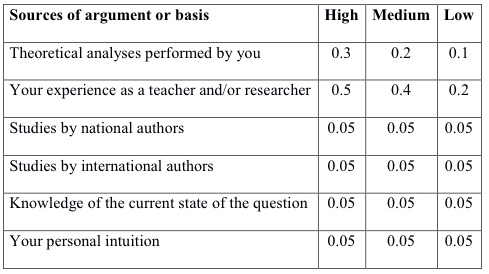
-----
Table 4
Summary table for the calculation of the expert coefficient
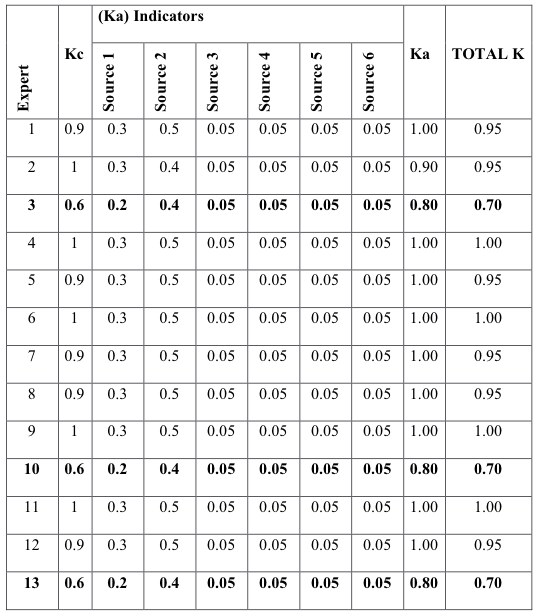
The sample was composed of a total of 325 students, of whom 81.5% were women and 18.5% were men. Regarding the age of the students, 52.9% were between 18 and 20 years old, 29.8% were between 21 and 23 years old, and 9.8% were between 24 and 26 years old. As the age of the students increases, the number of them decreases; in fact, 4.2% of the participants were over 30 years of age. The participants were all registered in the Faculty of Education Sciences, in the degrees of Primary Education (67.1%), Early Child Education (19.1%) and Pedagogy (13.5%) (see Table 5).
Table 5
Participating students by degree
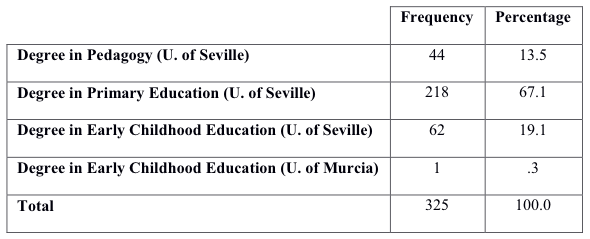
It was not possible to include students from the degree in Physical Education because the authors did not lecture in that degree during the academic year 2015-2016 and, although it was commented in some of the lectures of such degree, no questionnaires were obtained.
With regard to the year in which the students were registered, 56% of them were undertaking the first year, 12.9% were in the second year, 12.3% in the third year, and 18.8% of them were in the fourth year (see Table 6).
Table 6
Participating students by year
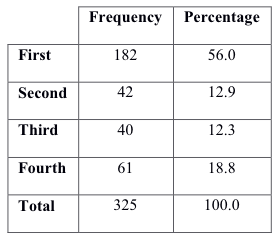
Regarding the group in which the participants were registered, 14.8% were in the first group, 8.6% in the second group, 32.9% in the third group, 2.2% in the fourth group, 16.3% in the sixth group, 4.3% in the seventh group, and 20.3% in the eighth group.
With respect to the analysis of the items related to the relevance and use of academic WhatsApp groups in modules of university degrees, the results obtained are detailed below.
To the question whether the use of an academic WhatsApp group would increase your motivation follow up and study the modules in which it is applied, 60.9% of the participants said that this would increase their motivation.
They were also asked whether participating in one of these groups would increase their interest on the module, to which 57.5% said that this would increase their interest. When they were asked whether by collaborating in an academic WhatsApp group the teacher could instantly send the students notifications related to the subject matter, in general, or the practical activities, in particular, 91.2% of the participants said that this would be very appropriate. When they were asked whether using an academic WhatsApp group would increase their participation in the modules in which it would be applied, 68.6% said that this would really increase their participation in those subject matters.
To the question whether its use would allow them to make group decisions on academic issues related to the modules (handing in assignments, revisions, lecturing, etc.), 80.5% of the participants said that this would allow them to make group decisions. When they were asked whether participating in academic WhatsApp groups would allow them to share pictures or videos with aspects related to the modules which could help to understand concepts, procedures or attitudes, 85.9% were in favour of using these groups to share this kind of files.
To the question whether the use of these groups is very useful because it would allow them to forward by e-mail the entire group conversation, or part of it, to one or several classmates, 71.4% agreed that they would use this application with such purpose. When they were asked whether the use of academic WhatsApp groups would develop even further their written expression and that of the other participating members of such group, 41.5% believed that these groups would not develop their written expression simply because they would be used in an educational manner.
To the question whether their participation in academic WhatsApp groups would develop even further their capacity to synthesise the information written and that of the other participating members, 61.4% said that these groups do not develop the capacity to synthesise the messages that are written in them.
With regard to whether the use of academic WhatsApp groups would enhance their critical thinking since questions that would generate a debate between teachers and students would be asked in these groups, 67.7% said that their critical thinking would be enhanced by participating in these debates.
To the question whether the use of an academic WhatsApp group would develop the shared building of knowledge among all the members of the group, 72.9% of the individuals surveyed said that a shared knowledge would be developed when exchanging information in this type of groups.
When they were asked whether the participation in these groups would enhance the expansion of information through additional documentary resources other than the ones provided by the teachers of the modules, 75.1% of the participants said that the additional resources would be considerably expanded in the modules in which academic WhatsApp groups would be used.
And lastly, regarding the question whether it would relevant and suitable to create an academic WhatsApp group as support for virtual tutoring in the modules of the degree, 74.7% of the students said that it would be relevant to create this type of groups in the modules of university degrees. Since the asymptotic significance in the following relationships was below 0.05 (minimum significance level), the null hypotheses were rejected and it was established that there is a relationship between the variables described (Hernández, 2016).
Among the analyses that showed that there was a relationship between variables, there were the participant age variable and the fact that they considered that the use of an academic WhatsApp group would increase their motivation to follow up and study the modules in which this was applied, as shown in Table 7.
Table 7
Pearson´s chi-squared value for the relationship between participants age and
“whether using an academic WhatsApp group would increase their motivation
to follow up and study the module”.
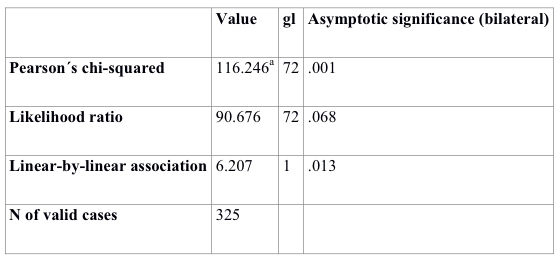
The following are other analyses to be considered (see Table 8):
a) It would be appropriate and relevant to create an academic WhatsApp group as support for virtual tutoring in the modules of the degree.
b) The use of these groups is very useful because it would allow them to forward by e-mail the entire group conversation, or part of it, to one or several classmates.
Table 8
Pearson´s chi-squared value for the relationship between the type of data plan
purchased and their valuation about the possibility to forward by e-mail the entire
group conversation, or part of it, to one or several classmates.
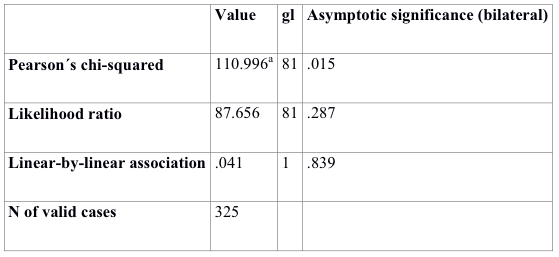
The results of the study allowed to draw the following conclusions:
a) The students in higher education have developed alternative communication systems with the use of academic WhatsApp groups in virtual tutoring. Therefore, we recommend its use with the guidelines we have pointed out about security, privacy and respect for all users.
b) The present study supports the tendencies proposed by the international observatories, such as Horizon 2020 (2017), in that mobile devices already constitute a great means of support for conventional educational organizations.
c) We have observed how the relationships among students were stimulated and enhanced and how the work teams were developed thanks to their collaboration. Nobody doubts that this mutual help cannot be carried out without the information and services provided by technological applications, such as the ones used in the present work.
d) The use of these technologies in other educational levels can prevent bullying and harassment.
e) We have identified those “flow areas” described by Castells (2007). Microelectronic networks of information and communication are generated. Therefore, the use of academic WhatsApp groups is ideal given their convenience, ease of use, usefulness and the attitude they produce in students.
This work was funded by the 2nd University Teaching Plan, Strategic Target: 1.3. (Aspects of Methodology, Academic and Professional Orientation, and Tutoring Action), Reference 1.10B or that of Innovation and Teaching Improvement Grants, 2015 Call, Modality B (Collaboration Networks for Teaching Innovation), with application number 2243, award reference number t1975 and a grant of 3,500€ whose coordinator is Dr. D. Alejandro Gómez Camacho, of the University of Seville (Call: https://ppropiodocencia.us.es/referencia_1_10B_15, Resolution: https://ppropiodocencia.us.es/sites/default/files/resoluciones2015/AnexoII_1.10.pdf); in addition to the call of research projects of the Didactic Research Group: Technological and quantitative analysis of the teaching-learning processes (HUM390) of the University of Seville.
Androutsopoulos, J. (2011). From Variation to Heteroglossia in the Sstudy of Computer-mediated Discourse. En C. Thurlow & K. Mroczek (eds.), Digital Discourse: Language in the New Media (pp. 277-298). Oxford: Oxford University Press.
Bañon, A. (2010). Las nuevas tecnologías y la comunicación de jóvenes y adolescentes. Usos y discursos. Interacçóes, 16, 64-89.
Baron, N. S. (2010). Always On: Language in an Online and Mobile World. Language Learning & Technology, 14(3), 19-22.
BASTOS, I. M., BOTTENTUIT, J. B., COSTA, L. M. & OLIVEIRA, W. A. O uso de ferramentas de interação e comunicação na orientação de trabalhos de conclusão de cursos a distância. Revista Espacios. Vol 37, year 2016, number 22, page e-2. Retrieved from:
http://www.revistaespacios.com/a16v37n22/163722e2.html
Bere, A. & Rambe, P. (2013). Extending Technology Acceptance Model in Mobile Learning Adoption: South African University of Technology Students' Perspectives. Proceedings of the International Conference on e-Learning (pp. 52-60).
Bere, A. (2012). A comparative study of student experiences of unquitious learning via mobile devices and learner management systems at a South African university. Proceedings of the 14th Annual Conference on World Wide Web Applications. Cape Penisula University of Technology (pp. 160-182).
Cabero, J. y Barroso, J. (2010). La investigación educativa en TIC. Visiones prácticas. Madrid: Editorial Síntesis.
Cabero, J. y Barroso, J. (2013). La utilización del juicio de experto para la evaluación de TIC, el coeficiente de competencia experta. Bordón. Revista de pedagogía, 65(2), 25-38.
Cabero, J. y Marín, V. (2013). Valoración del entorno formativo universitario DIPRO 2.0. Profesorado, Revista de Currículum y Formación de Profesorado, mayo-agosto, 369-383.
Castells, M. (2007). La transición a la sociedad Red. Barcelona: Ariel.
Chiluwa, I. (2010). Nigerian English in informal email messages. English World-Wide. A Journal of Varieties of English, 31(1), 40-61.
Church, K. & Oliveira, R. D. (2013). What's up with WhatsApp? Comparing mobile instant messaging behaviors with traditional SMS. MOBILE HCI - Collaboration and Communication (pp. 352-361).
Crystal, D. (2010). Language and the Internet. Cambridge: Cambridge University Press.
DE FREITAS, V. Intercambio de conocimiento entre los estudiantes de la Universidad Simón Bolívar-Venezuela: un caso de estudio. Revista Espacios. Vol 36, year 2015, number 5, page 18. Retrieved from:
http://www.revistaespacios.com/a15v36n05/15360518.html
Devi, T. S. & Tevera, S. (2014). Use of social networking site in the University of Swaziland by the health science students: A Case study. Journal of Information Management, 1(1), 19-26.
Durall, E., Gros, B., Maina, M., Johnson, L. y Adams, S. (2012). Perspectivas tecnológicas: educación superior en Iberoamérica 2012-2017. Austin, Texas: The New Media Consortium.
Flores, J. M. (2009). Nuevos modelos de comunicación, perfiles y tendencias en las redes sociales. Comunicar, 33, 73-81.
Fuentes, V., García, M. y Aranda, M. (2017). Grupos de clase, grupos de whatsapp. Análisis de las dinámicas comunicativas entre estudiantes universitarios. Prisma Social, 18 (junio 2017-noviembre 2017), 144-171.
Fundación Telefónica (Ed.) (2012). Aprender con tecnología. Investigación internacional sobre modelos educativos de futuro. Madrid: Fundación Telefónica y Editorial Ariel, S.A.
Fundación Telefónica (2014). The App Date. Retrieved on 24 de enero de 2017, from Las mejores apps, in The App Date Awards 2014:
Hernández, D. (2016). Así podría ser el futuro de WhatsApp. Retrieved on 28 de enero de 2016, from TICbeat:
http://www.ticbeat.com/tecnologias/podra-ser-el-futuro-de-whatsapp
Hernández, S., Fernández, C. y Baptista, L. (2007). Fundamentos de metodología de la investigación. Madrid: Mc Graw-Hill.
Horizonte 2020 (2017). Horizonte 2020. Retrieved on 3 de febrero de 2017, from Portal español del Programa Marco de Investigación e Innovación de la Unión Europea (Ministerio de Economía, Industria y Competitividad):
Hurtado de Mendoza, S. (2012). Criterio de expertos. Su procesamiento a través del método Delphy. Retrieved on 27 de octubre de 2016, from HISTODIDÁCTICA. Enseñanza de la Historia/Didáctica de las Ciencias Sociales:
http://www.ub.edu/histodidactica/index.php?option=com_content&view=article&id=21
Hwang, W., Huang, Y. & Wu, S. (2011). The effect of an MSN agent on learning community and achievement. Interactive Learning Environments, 19, 4, 413-432.
Karapanos, E., Teixeira, P. & Gouveia, R. (2016). Need fulfillment and experiences on social media: A case on Facebook and WhatsApp. Computers in Human Behavior, 55, 888-897.
Morales, G. (2016). Aspectos educativos de las redes sociales: un análisis de los factores que determinan su puesta en práctica. (Tesis doctoral inédita). Universidad de Sevilla. Sevilla.
Pérez, A., Valcárcel, N. y Colado, J. (2005). Método Delphy. La Habana: Universidad Pedagógica Enrique José Varona.
Pérez, C. & Montero, B. (2015). A first glimpse at mobile instant messaging: Some sociolinguistic determining factors. Poznan Studies in Contemporary Linguistics, 51(3), 411-431.
Plá, M. A. (2014). The discursive units in WhatsApp instant messaging. Estudios de Lingüística del Español, 35, 223-242.
Rambe, P. & Bere, A. (2013). Using mobile instant messaging to leverage learner participation and transform pedagogy at a South African University of Technology. British Journal of Educational Technology, 44, 544–561. doi: 10.1111/bjet.12057
Ruiz, C. (1998). Instrumentos de investigación educativa. Barquisimeto: Cideg.
Scopeo (2011). M-learning en España, Portugal y América Latina. Monográfico nº 3. Retrieved on 28 de mayo de 2016, from SCOPEO. Observatorio de la Formación en Red: http://scopeo.usal.es/wp-content/uploads/2013/04/scopeom003.pdf
Soliman, D. A. & Salem, M. S. (2014). Investigating intention to use mobile instant messenger: The influence of socialibility, selfexpressiveness and enjoyment. The Journal of American Academy of Business, Cambridge, 19(2), 286-293.
UNESCO (2017). Education for the 21st Century. Retrieved on 18 de enero de 2017, from UNESCO. United Nations Educational, Scientific and Cultural Organization:
http://en.unesco.org/themes/education-21st-century
Vázquez, E., Mengual, S. y Roig, R. (2015). Análisis lexicométrico de la especificidad de la escritura digital del adolescente en WhatsApp. RLA. Revista de lingüística teórica y aplicada, 53(1), 83-105.
Yeboah, J. & Ewur, G. D. (2014). The impact of WhatsApp messenger usage on students’ performance in Tertiary Institutions in Ghana. Journal of Education and Practice, 5(6), 157-164.
ZARTHA, J. W., MONTES, J. M., TORO, I. D. y VILLADA, H. S. Método Delphi - Propuesta para el cálculo del número de expertos en un estudio Delphi sobre empaques biodegradables al 2032. Revista Espacios. Vol 35, year 2014, number 13, pages 10-19. Retrieved from: http://www.revistaespacios.com/a14v35n13/14351310.html
1. PhD, Professor of the Department of Didactics and Educational Organization of the University of Seville, Seville, Spain. Contact e-mail: proman@us.es
2. PhD, Professor of the Department of Didactics and Educational Organization of the University of Seville, Seville, Spain. Contact e-mail: cballesteros@us.es
3. PhD, Professor of the Department of Didactics and Educational Organization of the University of Seville, Seville, Spain. Contact e-mail: noguera@us.es